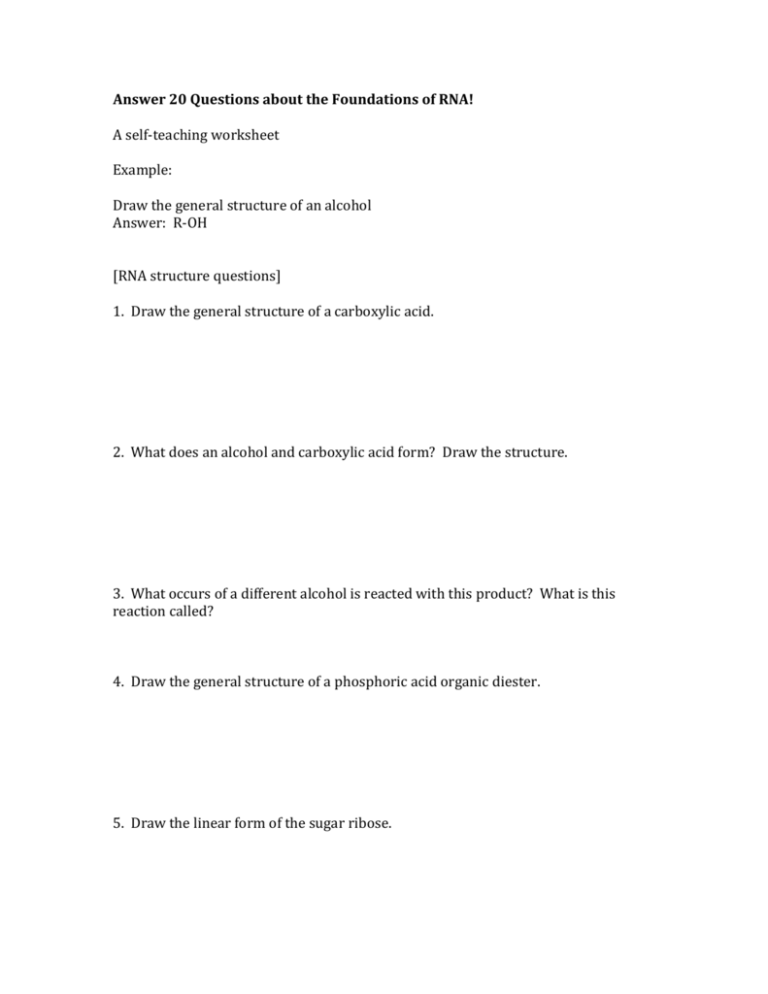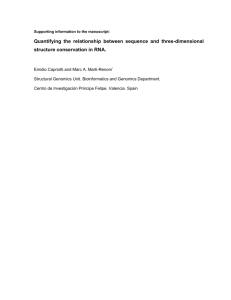Answer 20 Questions about the Foundations of RNA! A self
advertisement

Answer 20 Questions about the Foundations of RNA! A self-­‐teaching worksheet Example: Draw the general structure of an alcohol Answer: R-­‐OH [RNA structure questions] 1. Draw the general structure of a carboxylic acid. 2. What does an alcohol and carboxylic acid form? Draw the structure. 3. What occurs of a different alcohol is reacted with this product? What is this reaction called? 4. Draw the general structure of a phosphoric acid organic diester. 5. Draw the linear form of the sugar ribose. 6. Draw the circular form of ribose found in RNA (hint: use Wikipedia). Number the carbon atoms. 7. Draw the dehydration product of the form of ribose found in RNA reacted with a uracil base. What type of bond is formed between the ribose and the uracil? 8. Draw a two-­‐nucleotide segment of RNA that contains uracil bases. 9. Draw the products produced by mild alkaline treatment of the U-­‐U dinucleotide. Hint: the 2’OH of the ribose is deprotonted by base and then the negatively charged oxygen attacks the phosphate. 10. Draw UTP. Label the alpha, beta, and gamma phosphates. Label the bridging and non-­‐bridging oxygen atoms. Number the carbon and nitrogen atoms. 11. Draw an A-­‐U base pair. 12. Draw a G-­‐C base pair. [RNA labeling questions] 13. What enzyme and radionuclide would you use to place 32PO4 on the 5’ end of a synthetic oligonucleotide? 14. How many ‘counts per minute’ or cpm corresponds to 1 microCurie of a radionuclide? 15. If pure 32PO4 is 6000 Ci/mmol, what is the minimum number of molecules of 32P that can be detected (assume 300 cpm signal is easy to detect using a phosphorimager system or old-­‐fashioned scintillation counting)? [RNA analysis] 16. What is the structure of acrylamide and N,N-­‐methylene-­‐bis-­‐acrylamide? 17. In addition to the compounds from (14) what additional compounds are necessary to produce a denaturing polyacrylamide gel for separating RNA molecules? 18. What is the resolution limit (for RNA) for a denaturing polyacrylamide gel? 19. How would you use a 5’ end-­‐labeled oligonucleotide and reverse transcriptase to identify the 5’ end of an RNA to which the oligonucleotide is complementary (hint: this is called a ‘primer-­‐extension’ assay)? 20. How would you identify the 3’ end (i.e. the last nucleotide) of a specific RNA molecule in the cell?





